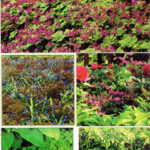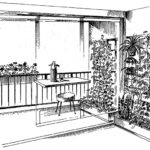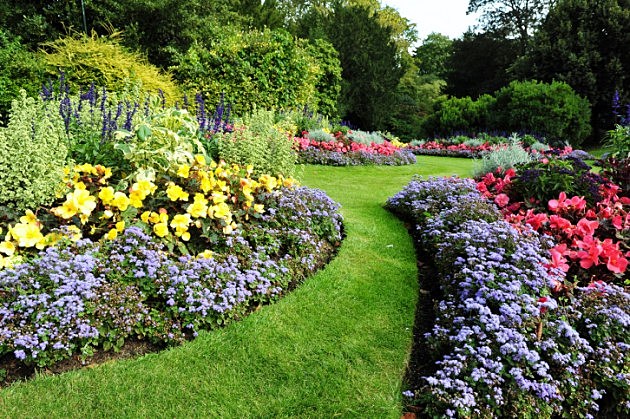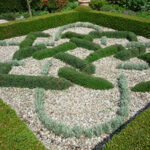Towarzystwo dla bylin – ozdobne ramy. Byliny okrywowe i krzewy wokół rabat.
Rabaty bylinowe mogą służyć jako ozdobne uzupełnienie trawników albo tarasów. Ale i same także mogą być wykończone kolorowym lub zielonym obramowaniem.
Im bardziej kolorowe byliny, tym ładniejszy kontrast z żywopłotem.
Żywopłot bukszpanowy o bardzo ciekawym kształcie – po bokach rabaty niski i kanciasty, w narożnikach zaś w postaci kul.
Grab jest popularny nie tylko jako obramowanie rabat, lecz przede wszystkim jako zielony płot. Żywopłoty z niego są gęste, ale zielone tylko latem.
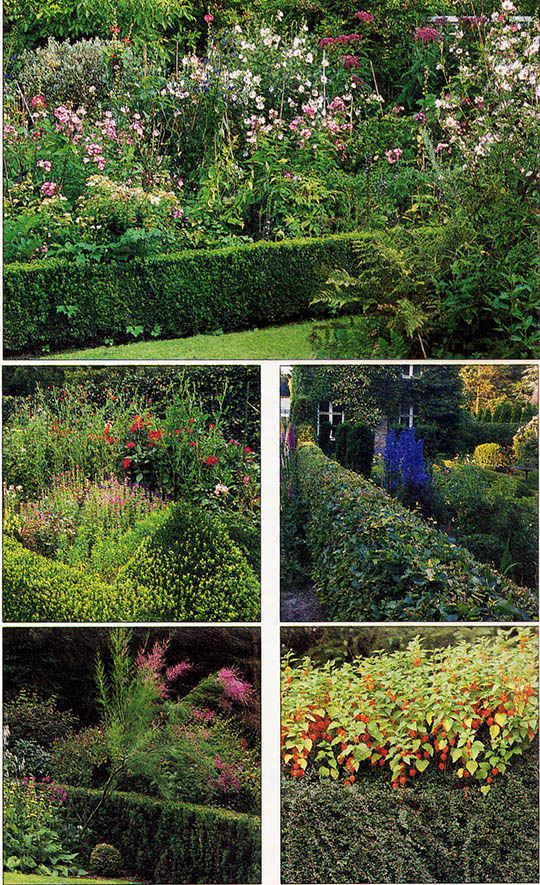
Cisy mają ciemnozielone igły, na których tle pięknie wyglądają wszystkie inne kolory. Nawet nie przycinane wyglądają bardzo atrakcyjnie.
Irga wymaga częstego przycinania, rośnie bowiem bardzo szybko i łatwo się rozkrzewia. Doskonała na niskie obramowania rabat.
Niskie żywopłoty, kolorowe kępy kwitnących bylin czy obsypane kwiatem krzewy – każdy rodzaj obramowania i wykończenia będzie wyglądać bardzo efektownie jako dopełnienie rabaty bylinowej. Wybór właściwych roślin zależy od wyboru gatunków bylin, ale także od charakteru całego ogrodu. W ogrodzie regularnym dobrze wyglądają żywopłoty formowane, bogato kwitnące. Rozrośnięte, splątane krzewy pasują raczej do ogrodów naturalnych.
Szczelna zieleń, perfekcyjna forma.
Bukszpan to klasyczna roślina na wszelkiego rodzaju żywopłoty formowane. W ogrodzie w stylu wiejskim może stanowić obramowanie rabat obsadzonych kolorowo kwitnącymi roślinami, w parkach formuje się z niego żywopłoty różnej wielkości i o najróżniejszych kształtach, jakie tylko można sobie wyobrazić.
Rośliną tańszą od bukszpanu, ale o identycznym zastosowaniu, jest liguster. Nie przycinany pokrywa się w lipcu białymi kwiatami, zebranymi w kwiatostany wiechowate, z których powstają później grona granatowych jagód.
Rolę spokojnego tła kolorowych grządek może pełnić ciemny cis. Wyjątkowo ładnie wygląda jesienią, gdy między ciemną zielenią liści lśnią małe, czerwone jagody. Wysokość żywopłotu zależy od sposobu obsadzenia rabaty – krzewy mogą zapewnić doskonalą ochronę przed wiatrem bylinom wysokim, ale nie mogą przy tym zasłonić mniejszych bylin.
Zielony łuk nad wejściem. Aby móc pracować wewnątrz rabaty bylinowej, trzeba zapewnić odpowiednie przejście w żywopłocie. Bardzo efektownie wyglądają niewielkie furtki, zamknięte u góry zielonym tukiem. Przejście można także zamaskować roślinami przy-ciętymi na kształt kolumny.
Zielony gąszcz pokryty kwiatami.
Kwitnące krzewy oddzielające rabatę bylinową od innych części ogrodu wyglądają jak część grządki. Wiele spośród wspaniale kwitnących, bardzo dekoracyjnych krzewów można także dowolnie przycinać. O ostatecznym wyborze decyduje kolor ich kwiatów (dopasowany do kolorów kwitnących bylin) oraz ich wysokość. Jeśli planujemy tylko obsadzenie brzegu kolorowej grządki, możemy wykorzystać do tego celu na przykład pięciornik, ozdobny pigwowiec, barbulę (Caryopteris) i tawulę.
Aby kwitnące krzewy mogły pokazać się z najpiękniejszej strony, należy zachować pewną ostrożność podczas ich cięcia. Po przekwitnięciu pędy mogą być skracane, jednak w miarę możliwości powinny rosnąć jak najbardziej dowolnie, tylko wówczas bowiem wytwarzają dużo pąków kwiatowych.
Na obrzeżach rabat pięknie wyglądają także hortensje. Nie można ich jednak przycinać, bowiem kwitną na pędach jednorocznych.
Jaśminowiec to bardzo popularny krzew ogrodowy. Na grządki z bylinami należy wybierać odmiany niskie.
Porzeczka ozdobna jest bardzo dekoracyjna. Krzew można formować, ale wtedy tak ładnie nie kwitnie.
Pigwowiec japoński może osiągać wysokość do 2 m. Dobrze znosi przycinanie i można go formować w krzew.
Pięciornik kwitnie bardzo wcześnie. Nie ma specjalnych wymagań i doskonale znosi przycinanie.
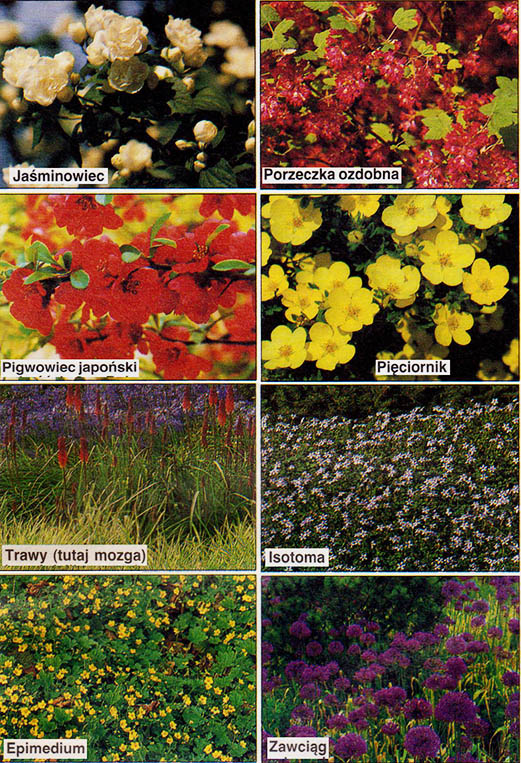
Trawy (tutaj mozga) tworzą ramy rabaty i delikatne połączenie jej z trawnikiem.
Isotoma to bardzo piękna, ale rzadka roślina. Jest polecana w chłodniejszych okolicach.
Epimedium lubi wilgotne, chłodne podłoże i dobrze znosi półcień. Niektóre odmiany są zimozielone.
Zawciąg jest dekoracyjny przez cały rok – wiosną ma lila kwiatki, później podłużne liście.
Kępy niskich bylin, we wszystkich kolorach.
Kępy bylin mogą tworzyć ozdobne kolorowe plamy na krawędzi rabaty. Z powodzeniem można je więc sadzić na obrzeżach, dookoła grządek. Jedynym warunkiem właściwego doboru roślin jest ich wysokość – obrzeże zawsze musi być kilka centymetrów niższe od najniższych roślin na rabacie. Kolorowe obramowanie rabaty może wydobyć lub podkreślić podstawowy kolor bylin. Przejście między grządką a powierzchnią trawnika można złagodzić planując na ich granicy ozdobne trawy o innych odcieniach zieleni albo bylin o ozdobnych liściach.
Wszystkie byliny tworzące barwne poduchy potrzebują bardzo dobrze przygotowanej gleby. W miarę wzrostu tworzą bowiem gęstą plątaninę pędów, liści i kwiatów, wręcz uniemożliwiającą późniejsze odchwaszczanie czy spulchnianie gleby. Byliny najlepiej zasilać nawozami w postaci płynnej, bo kompost, jakim okrywamy rośliny na zimę, zawiera zbyt mało składników odżywczych.
Tabela – wybór roślin.
| Krzewy zimozielone | Krzewy kwitnące | Kwitnące byliny okrywowe |
| Berberis buxifolia (do 40 cm) | Berberis wilsoniae (do 2 m) | Alyssum saxatile (do 30 cm) |
| Buxus sempervirens (do 40 cm) | Chaenometes japonica (do 2 m) | Aubrieta x cultorum (do 10 cm) |
| Berberis verruculosa (do 1 m) | Cotoneaster divaricatus (do 3 m) | Cerastium tomentosum (do 15 cm) |
| llex crenata (do 1 m) | Deutzia gracilis (do 1 m) | Dianthus plumarius (do 30 cm) |
| Prunus laurocerasus (do 1 m) | Kerria japonica (do 2 m) | Iberis sempervirens (do 20 cm) |
| Taxus baccata (do 1 m) | Philadelphus lemoinei (do 2 m) | Lavandula angustifolia (do 30 cm) |
| Ligustrum vulgare (do 2 m) | Potentilla fruticosa (do 1,50 m) | Phlox subulata (do 10 cm) |
| Thuja plicata (do 2 m) | Rosa rugosa (do 1,50 m) | Saxifragaa x arendsii (do 15 cm) |
